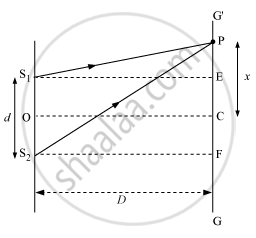Advertisements
Advertisements
Question
Why cannot two independent monochromatic sources produce sustained interference pattern?
Deduce, with the help of Young's arrangement to produce interference pattern, an expression for the fringe width.
Solution
To produce a sustained interference pattern, the two sources of light must be coherent. In other words, they should emit continuous light waves (of the same wavelength or frequency) that have either the the same phase or a constant phase difference. Two independent monochromatic sources are not coherent. Hence, they cannot produce a sustained interference pattern.

Let S1 and S2 be two slits separated by a distance d. GG' is the screen at a distance D from the slits S1and S2. Point C is equidistant from both the slits. The intensity of light will be maximum at this point because the path difference of the waves reaching this point will be zero.
At point P, the path difference between the rays coming from the slits is given by
S1 = S2P ‒ S1P.
Now,
S1S2 = d, EF = d and S2F = D
∴ In ΔS2PF,
`S_2P = [S_2F^2 + PF^2]^(1/2)`
`S_2P = [D^2+(x +d/2)^2 ]^(1/2)`
`= D [1 +D^2+((x +d/2)^2)/D^2 ]^(1/2)`
Similarly, in ΔS1PE,
`S_1P= D [1 +((x -d/2)^2)/D^2 ]^(1/2)`
∴`S_2P-S_1P=D [1 +1/2((x + d/2)^2)/D^2 ] - D [1 +1/2((x -d/2)^2)/D^2 ]`
On expanding it binomially, we get
`S_2P - S_1P = 1/(2D)[4xd/2] =\ (xd)/D`
For bright fringes (constructive interference), the path difference is an integral multiple of wavelengths, that is, nλ.
∴ `nλ = (xd)/D`
`x =(nλD)/d`
Here,
n = 0, 1, 2, 3, 4, …
For n = 0, x0 = 0
`n = 1, X_1 =(λD)/d `
`n = 2, X_2 =(2λD)/d `
`n = 3, X_3 =(3λD)/d `
`n = n, X_n =(nλD)/d `
Fringe Width (β)
Separation between two consecutive bright fringes is called the width of a dark fringe.
\[\beta_1 = x_n - x_{n - 1} = \frac{\lambda D}{d}\]
Similarly, for dark fringes,
`x_n = (2n - 1)λ/2 D/d`
For `n =1,x_1 (λD)/(2d)`
For `n =2,x_2= (3λD)/(2d)`
Separation between two consecutive dark interference fringes is called the width of a bright fringe.
\[\beta_2 = x_n - x_{n - 1} = \frac{\lambda D}{d}\]
∴ β1 = β2
All the bright and dark fringes are of equal width, as β1 = β2.
APPEARS IN
RELATED QUESTIONS
A parallel beam of light of wavelength 500 nm falls on a narrow slit and the resulting diffraction pattern is observed on a screen 1 m away. It is observed that the first minimum is at a distance of 2.5 mm from the centre of the screen. Find the width of the slit.
In deriving the single slit diffraction pattern, it was stated that the intensity is zero at angles of nλ/a. Justify this by suitably dividing the slit to bring out the cancellation.
Draw the intensity pattern for single slit diffraction.
Draw the intensity pattern for double slit interference.
State differences between interference and diffraction patterns.
(i) State the essential conditions for diffraction of light.
(ii) Explain diffraction of light due to a narrow single slit and the formation of pattern of fringes on the screen.
(iii) Find the relation for width of central maximum in terms of wavelength 'λ', width of slit 'a', and separation between slit and screen 'D'.
(iv) If the width of the slit is made double the original width, how does it affect the size and intensity of the central band?
A parallel beam of light of 450 nm falls on a narrow slit and the resulting diffraction pattern is observed on a screen 1.5 m away. It is observed that the first minimum is at a distance of 3 mm from the centre of the screen. Calculate the width of the slit.
Derive the relation a sin θ = λ for the first minimum of the diffraction pattern produced due to a single slit of width ‘a’ using light of wavelength λ.
Using the monochromatic light of same wavelength in the experimental set-up of the diffraction pattern as well as in the interference pattern where the slit separation is 1 mm, 10 interference fringes are found to be within the central maximum of the diffraction pattern. Determine the width of the single slit, if the screen is kept at the same distance from the slit in the two cases.
Derive the relation a sin θ = λ for the first minimum of the diffraction pattern produced due to a single slit of width 'a' using light of wavelength λ.
